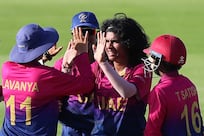THE BASICS, PART ONE The Moon is Earth's only natural satellite. Scientists believe it formed around 4.3 billion years ago from material ejected from Earth when it was struck by a Mars-sized object. It is composed primarily of oxygen, silicon, magnesium, iron, calcium, aluminium, suphur and nickel - not, as the 16th-century proverb would have it, of green cheese. (No cow ever jumped over it, either.)
THE BASICS, PART TWO The Moon is about 384,000km from Earth on average. It has no atmosphere. It has a dry, dusty, rocky surface. It has colossal mountain ranges; low, flat areas that early astronomers thought were seas; and, of course, millions of impact craters caused by asteroids, comets and meteorites. "Magnificent desolation", summed up Edwin "Buzz" Aldrin, the second man to walk on the Moon.
TIDAL WAVES The Moon's gravitational attraction makes the oceans of the Earth bulge out in the direction of the satellite. Another bulge occurs on the opposite side, since the whole of Earth is also being pulled toward the Moon (and away from the water on the far side). Since the Earth is rotating while this is happening, two tides occur each day.
FIRST FEATS The Luna programme of the then-Soviet Union was the first to reach the Moon with unmanned spacecraft in 1959. The United States' Apollo programme achieved the only manned missions. Neil Armstrong, during the Apollo 11 mission, was the first man to set foot on the Moon, on July 20, 1969.
SEEING THINGS Observers from various cultures throughout history have perceived a human or an animal figure in the bright disc of the full Moon. A man, a woman, a rabbit, a toad and a toadstool, a crab, a dragon - all these and more have been spotted.
LONGEST DRIVE EVER Alan Shepard, the first American in space and commander of Apollo 14 in 1971, used a Wilson six-iron head attached to a lunar sample scoop handle to drive two golf balls on the Moon. The second, he said, went "miles and miles and miles".
BAD MOON, PART ONE It's a widely held belief that the full Moon correlates to deviant behaviour, including crime. But the evidence is anecdotal if not apocryphal, and most academics reject this notion as pseudoscientific theory.
BAD MOON, PART TWO The eerie light of the full Moon also is said to play a role in lycanthropy, the process in which a man transforms himself or is involuntarily transformed into a werewolf. The Instant Expert does not believe in werewolves, though he will always remember the remarkable thespian talents of the late US actor Michael Landon in the 1957 film I Was a Teenage Werewolf.
WISHFUL THINKING With no atmosphere, extreme temperatures and apparently no water, life on the Moon seems highly improbable. Still, there is some speculation that microbial life, perhaps in the form of dormant spores, may have been deposited by meteorites.
IN SONG The Moon has inspired many a singer and songwriter, across the ages and the musical spectrum. The Instant Expert's Luna-loving Top 10: Bad Moon Rising (Credence Clearwater Revival), Fly Me to the Moon (Frank Sinatra), Harvest Moon (Neil Young), How High the Moon (Sarah Vaughan), It's Only a Paper Moon (Nat "King" Cole), Moondance (Van Morrison), "Moonlight" Sonata, Op 27, No 2 (Ludwig van Beethoven), Moon River (Andy Williams and Henry Mancini), Moonshadow (Cat Stevens, aka Yusuf Islam), Swingin' on the Moon (Mel Torme).
THE DISSENTING OPINION An astonishing number of dimwits believe the US Moon landings were a hoax. These people are to be pitied for a) their ignorance or b) their lunacy.
On the big screen
DESTINATION MOON (1950) Produced by George Pal, who went on to bring When Worlds Collide, The War of the Worlds and The Time Machine to cinemas, this was the first major US science-fiction film to deal realistically with space travel. The sci-fi writer Robert A Heinlein contributed significantly to the script and served as a technical adviser.
2001: A SPACE ODYSSEY (1968) The scientific realism and pioneering special effects, especially those involving the Moon, are stunning in this epic Stanley Kubrick-Arthur C Clarke collaboration.
MOON (2009) This sci-fi feature by the first-time director Duncan Jones - whose father is David Bowie - was honoured as best film by the British Independent Film Awards. Sam Rockwell stars as a helium miner on the Moon who experiences a personal crisis, and Kevin Spacey is the voice of his robot companion.
APOLLO 13 (1995) "Houston, we have a problem." Tom Hanks shines as astronaut Jim Lovell, Kevin Bacon portrays Jack Swigert and Ed Harris plays the Nasa flight director Gene Krantz ("Failure is not an option") in this tense drama adapted from Lovell's book about the successful challenge to bring a crippled US lunar spacecraft home safely.




